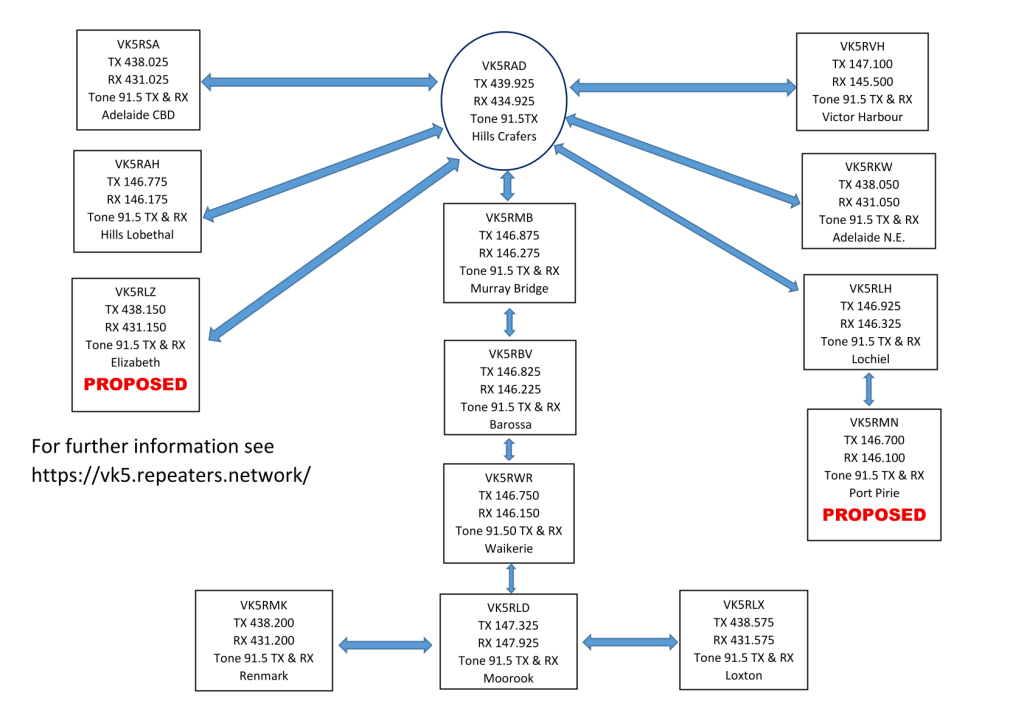In Adelaide and South Australia we have a whole bunch of hardly-used voice repeaters.
Dean, VK5HMV
Why don’t we link them all together and have a whole network of under-utilized repeaters ?
Welcome to the Adelaide ‘Repeaterlink’ Network
The Basics
‘Repeaterlink’ consists of various VHF and UHF FM analogue voice repeaters in the Adelaide and adjoining areas being all linked together – such that when you access any of the individual repeaters you are simultaneously broadcasting on all of the repeaters in the network.
The linking of the repeaters extends your coverage area significantly and allows you to access a much larger area than a single repeater on its own.
UHF repeaters – CBD and metro/local township areas
VHF repeaters – regional and country areas
List of Repeaters in network
** 91.5hz tone (encode) is required to access all repeaters in the network.
| VK5RSA | Adelaide CBD | UHF | 438.025 Mhz | -7Mhz | 91.5HZ ctcss encode/decode |
| VK5RAD | Hills – Crafers | UHF | 439.925 Mhz | -5Mhz | 91.5HZ ctcss encode/decode |
| VK5RKW | Adelaide NE | UHF | 438.050 Mhz | -7Mhz | 91.5HZ ctcss encode/decode |
| VK5RAH | Hills – Lobethal | VHF | 146.775 Mhz | -600Khz | 91.5HZ ctcss encode/decode |
| VK5RMB | Murray Bridge | VHF | 146.875 Mhz | -600Khz | 91.5HZ ctcss encode/decode |
| VK5RVH | Victor Harbor | VHF | 147.100 Mhz | -1.6Mhz | 91.5HZ ctcss encode/decode |
| VK5RWR | Riverland – Waikerie | VHF | 146.750 Mhz | -600Khz | 91.5HZ ctcss encode/decode |
| VK5RLD | Riverland – Moorook | VHF | 147.325 Mhz | +600Khz | 91.5HZ ctcss encode/decode |
| VK5RMK | Riverland -Renmark | UHF | 438.200 Mhz | -7Mhz | 91.5HZ ctcss encode/decode |
| VK5RBV | Barossa -Mt Kitchener | VHF | 146.825 Mhz | -600Khz | 91.5HZ ctcss encode/decode |
| VK5RLH | Lochiel -BumBunga Hill | VHF | 146.925 Mhz | -600Khz | 91.5HZ ctcss encode/decode |
| VK5RLX | Loxton | UHF | 438.575 | -7Mhz | 91.5HZ ctcss encode/decode |
Programming your radio
When programming the frequencies into your radio be aware that not all of these repeaters use the standard 600khz / 5mhz split. Please refer to the list above when programming your radio.
Handhelds
When using handhelds your audio is at a disadvantage – lower power output levels and less than ideal microphone performance are not conducive to transmitting a clear signal into your local repeater. Please spend some time setting up your microphone gain and identify where the microphone opening is on your handheld. If your mike gain is set correctly and your speak firmly into the mic, you give yourself the best chance of transmitting clear and powerful audio into the network.
CTCSS / Tone Squelch
It is preferable to use both ctcss encode AND decode (tone squelch) on repeaters that have this ability activated. The customary ‘noise crash’ at the end of a transmission is greatly reduced if this feature is enabled – making your communication on the network a more enjoyable experience. If you do not activate your ‘encode’ feature – access to a repeater that utilizes this feature is not possible.
‘Repeaterlink’ setup
The Adelaide Repeaterlink Network brings together the repeaters that are owned and operated by various SA amateur radio clubs and individuals in Adelaide and surrounding regions. This is done in the hope of creating more activity and promoting more communication between operators in South Australia.

Using The Linked Repeaters
Using the Linked Repeaters is no different to using any other analogue FM repeater. The only difference is that when you transmit into any 1 of the linked repeaters, you are transmitting out ALL repeaters in the system at the same time. As a matter of courtesy, with so many repeaters linked, leave a 1-2 second gap between overs – you never know who is listening in the network who may want to pop in and say hi!
When calling, announce which repeater you are accessing the network from.
Each repeater has its own unique courtesy tone or ‘beep’ and the end of transmission. This helps to identify which repeater the signal you are listening to has come from. A list of the different sounding ‘beeps’ will be available to listen to on this site soon.
Linking method
A decision was made in regards to the linking and that it would all be done via RF. This method of linking was chosen to keep the system relevant (we are all HAM operators after all) and to develop a high degree of independence and reliability within the linking system. In times of emergency or public utility failure the system is unaffected and continues to operate at full capacity.
When the power is out, when the internet is down – this network keeps working
Dean, VK5HMV
The network utilizes 2 different methods of linking all of the repeaters together.
*Hub and Spoke
*Backbone
This enables the system to be very versatile and have excellent flexibility when additions or changes need to be made.
Considerable effort has been made to ensure that before a new repeater is linked into the system that it is compatible and is able to mesh seamlessly into the existing system. Things such as audio levels and controller commands are carefully set-up and balanced across the entire network, and that the link path has a suitable strong signal to be noise free. Reliability of the system is of highest priority and is constantly monitored to ensure the system operation is maintained and of high quality.
Unless you listen to the courtesy tones you cannot tell which repeater is talking to you.
Shane, VK5NRV
